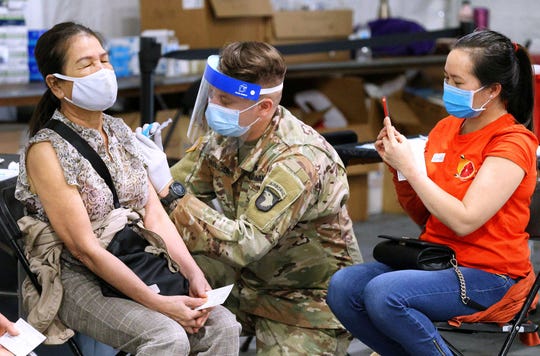CDC report: Disparities in COVID-19 vaccinations seen in ‘majority’ of states, vulnerable counties impacted most
A majority of states are experiencing disparities in getting the COVID-19 vaccine to vulnerable communities, a report from the Centers for Disease Control and Prevention shows.
Vulnerable counties tend to have lower COVID-19 vaccination rates, according to the CDC’s Morbidity and Mortality Weekly Report released this week.
The CDC used a Social Vulnerability Index (SVI) to rank counties based on a combination of certain factors: a high percentage of racial or ethnic minorities, seniors, single-parent households, people living below poverty, mobile homes residents, people with disabilities, or those without a car, among others characteristics.
The study then looked at vaccine administration data for more than 49 million U.S. residents between Dec. 2020 and March 1 and found that, on average, less vulnerable counties had a vaccination rate 2.5 percentage points higher than counties with high social vulnerability.
Researchers found the disparity nationwide.
“Although vaccination coverage estimates by county-level social vulnerability varied widely among states, disparities in vaccination coverage were observed in the majority of states,” wrote the authors, which included CDC epidemiologist Michelle Hughes and coordinator of the CDC’s SVI Danielle Sharpe, among several others.
They found the largest disparities in counties that ranked high in socioeconomic vulnerability, such as high rates of poverty or unemployment.
“In the first 2.5 months of the program, vaccination coverage was lower in high vulnerability counties nationwide, demonstrating that additional efforts are needed to achieve equity in vaccination coverage for those who have been most affected by COVID-19,” the authors wrote, imploring public health officials to improve COVID-19 vaccine coverage in majority-minority counties by monitoring community-level metrics for “tailored” vaccine delivery.

A mother and daughter receive COVID-19 vaccines as Floridians continue to receive shots at the FEMA-supported Vaccination Site at Valencia College West Campus in Orlando, Florida. (Photo: Joe Burbank, AP Images)
Dharma Cortés, a sociologist and senior scientist with the Health Equity Research Lab and Harvard Medical School-affiliated Cambridge Health Alliance, said the results aren’t surprising.
“These complex factors that shape the lives of these people have a tremendous impact on their ability to get vaccinated,” said Cortés, a medical anthropology expert. “The same factors that shape the disproportionate impact of COVID-19 on these populations are again shaping the way they are actually getting vaccinated or not.”
She added many people struggling to make ends meet are working multiple jobs, making it difficult to take time off to get the shot.
“When people have more than one job, they don’t have time to go and spend hours calling to make an appointment to get a vaccine or surfing the internet to find a site where they actually can sign up for these vaccines,” she said. “Another barrier is transportation. If you have to travel far to get vaccine, spend hours waiting, that definitely has an impact on their livelihood.”
Communities that are achieving equity
But some states, such as Arizona and Montana, achieved the opposite of the prevailing disparity – with higher vaccination rates among people living in vulnerable communities.
The researchers noticed a pattern: States with high equity often prioritized people of color during the early stages of rollout, monitored barriers to getting the shot and worked with community or tribal organizations. These states also offered free transportation to vaccination sites.
“More investigation is needed to understand these differences to identify best practices to achieve COVID-19 vaccination equity,” the authors wrote.
Also, the researchers found equal vaccination rates among low and high vulnerability counties when it came to certain measures such as the percentage of people with limited English proficiency or with disabilities. Since COVID-19 disproportionately impacts those populations, they noted the finding was encouraging.
Since “COVID-19 vaccination equity varied among states,” the researchers also recommended states and counties to identify Census tracts with the highest risk factors to prioritize vaccine delivery at a more granular, targeted level.
“Despite these positive findings, equity in access to COVID-19 vaccination has not been achieved nationwide,” the authors wrote.
- Coronavirus Watch: AstraZeneca vaccine is safe, European regulator says
- Latino vaccination rates lag in Texas, and the gap is especially wide in Austin
- For the most vulnerable Americans, these clinics are trusted, accessible and vital to vaccine rollout
- ‘Just not equal at all’: Vaccine rollout in Chicago a microcosm of racial disparities nationwide
Reach Nada Hassanein at [email protected] or on Twitter @nhassanein_.
Source: Read Full Article

